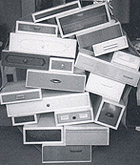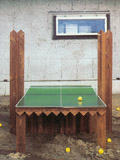 |
||
|
softcore news < studios < articles < hardcore firms < jobs < schools < materials < calendar < sources < discussion < how to < |
||


> > archived articles > write for core! be famous!
|
Droog at the Design Museum London, February 2, 2003 - After our recent continental sojourns the diary returns to London, though our subject is once again Dutch. Last month the Design Museum hosted a talk by Renny Ramakers, co-founder of the Dutch collective Droog Design. Ramakers talk proved so popular many were left standing for the duration (the Design Museum is the last place you’d expect to find a shortage of chairs!) This year Droog has curated the Design Museums' Conran Foundation Collection. The collection is a kind of fantasy-shopping spree. £30,000 is given to a different designer or group every year to buy the things they would 'like to live with'. Reflecting the Droog mentality, the objects they selected were functional, understated and often witty. The collection included what must be the Design Museums first IKEA product, a wire whisk that sells for £1.73. Droog Design is an act of curation and art direction by Ramakers (a design writer) and fellow founder Gijs Bakker (a former jeweler and teacher). The 120 objects in the show have been chosen on gut feel. Between them, Ramakers and Bakker have developed a coherent narrative from the work they see being generated--originally by young Dutch designers and now by designers worldwide.
|
|
|
| Being art directors instead of studio managers allows Droog the freedom to quickly mutate, to adopt new talent and to continue to work with old favorites. Since 1993, Droog has moved between making art objects and design consultancy, operating across product, graphics, interiors and architecture. When asked, at the Design Museum, to clarify exactly what Droog is, Renny responded that "Droog is a mentality." Droog are the nearest thing we have to a bona fide design movement these days, and their work consistently stands out from the rest of the crowd. At the Milan furniture fair--which has become their main platform for showing new work--the conceptual strength of their work combined with its humor and accessibility consistently makes the shish Italian designerware and designer/maker one liners look like a bad joke.
|
 Kronan Kargo Bike. One of the objects chosen for Droogs' collection of objects they'd 'like to live with.' |
|
| Ramakers recent book, Less and More, though located primarily in the territory of furniture and homewares, reads as an informed insight into design now and the cultural paradoxes which affect it. The title, she writes, "…refers to the paradox of the coexistence of less and more that resonates in our modern western culture." In the introduction, Ramakers highlights key issues of materiality to which the Droog Collection directly responds: "In some ways the world around us is getting less material,
yet at the same time the concern for material things has never been
greater. On the one hand there is a keen interest in designing processes
services and strategies, regardless of materiality; on the other
there is clearly a craving for physical experience, with materials
squarely at the centre of attention."
|
 Tejo Remy's, Chest of Drawers. Image from Droog Design Newsletter 4, April 1999 |
|
| The work of Droog challenges what is, almost by definition, the universal given of design, what Ramakers calls the 'ideology of the new.' That is, the need to make something new and in some cases the need to make anything at all. Droog argue that the mass-produced glossy perfection of new objects creates a distance between them and the people who buy them; they offer a poor physical experience. Droog propose objects which allow for relationships to form, objects that play with the ideas of imperfection, reuse, interaction, tactility, craft and the lifespan of the object itself. Droog is not only a reaction to paradox, the Droog mentality is in fact paradoxical. Their work is a criticism of consumer culture, yet they are eager to commercialize and mass produce as much of it as is viable. They make furniture (like Tejo Remy's seminal chest of drawers, 'You can't lay down your memories'), which they claim is 'no design'--indeed against design--yet their pieces are snapped up by galleries and design museums worldwide. They say that style creates distance between people and the objects, yet their work has developed a common sense of non-style and is essentially design with a big 'D'. Droog's products claim to offer richer physical experience, but
in the same way that Droog is a mentality, their products are to
be consumed for their message. As predominantly limited edition
items, their work has to be seen essentially as an act of communication.
It's the paradoxical mentality that makes them smart and worth listening
to. |
 Next Architects Table tennis fence, based on the design of the typical Dutch Fence. Firsts exhibited in Salone del Mobile Milan 2001. Image from me myself and you, Droog Design, 2001 |
|
The Droog, Conran Foundation Collection is on exhibition at the Design Museum London until February 9 2003. The Placebo Project: The secret life of electronic objects, a project by Dunne & Raby, is on exhibition at Droog & Co., Amsterdam until February 15 2003. If we heard them correctly Droog may be exhibiting some work with a major consumer electronics manufacturer at Salone del Mobile Milan 2003, from 22 April. Watch this space and we’ll keep you informed - that’s if we can get Core to pay for our tickets ;-)
|
||
|
>> back to top >> back to core |
||
